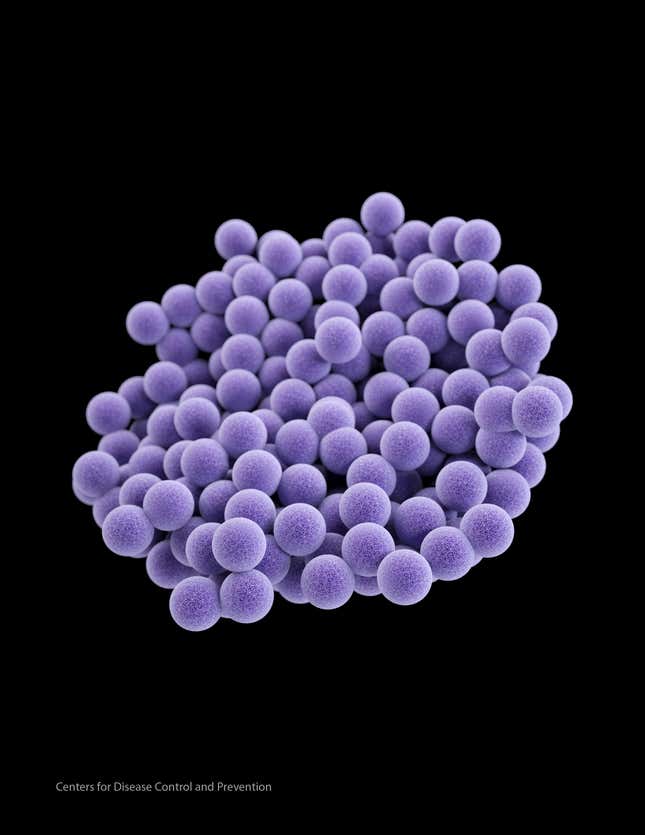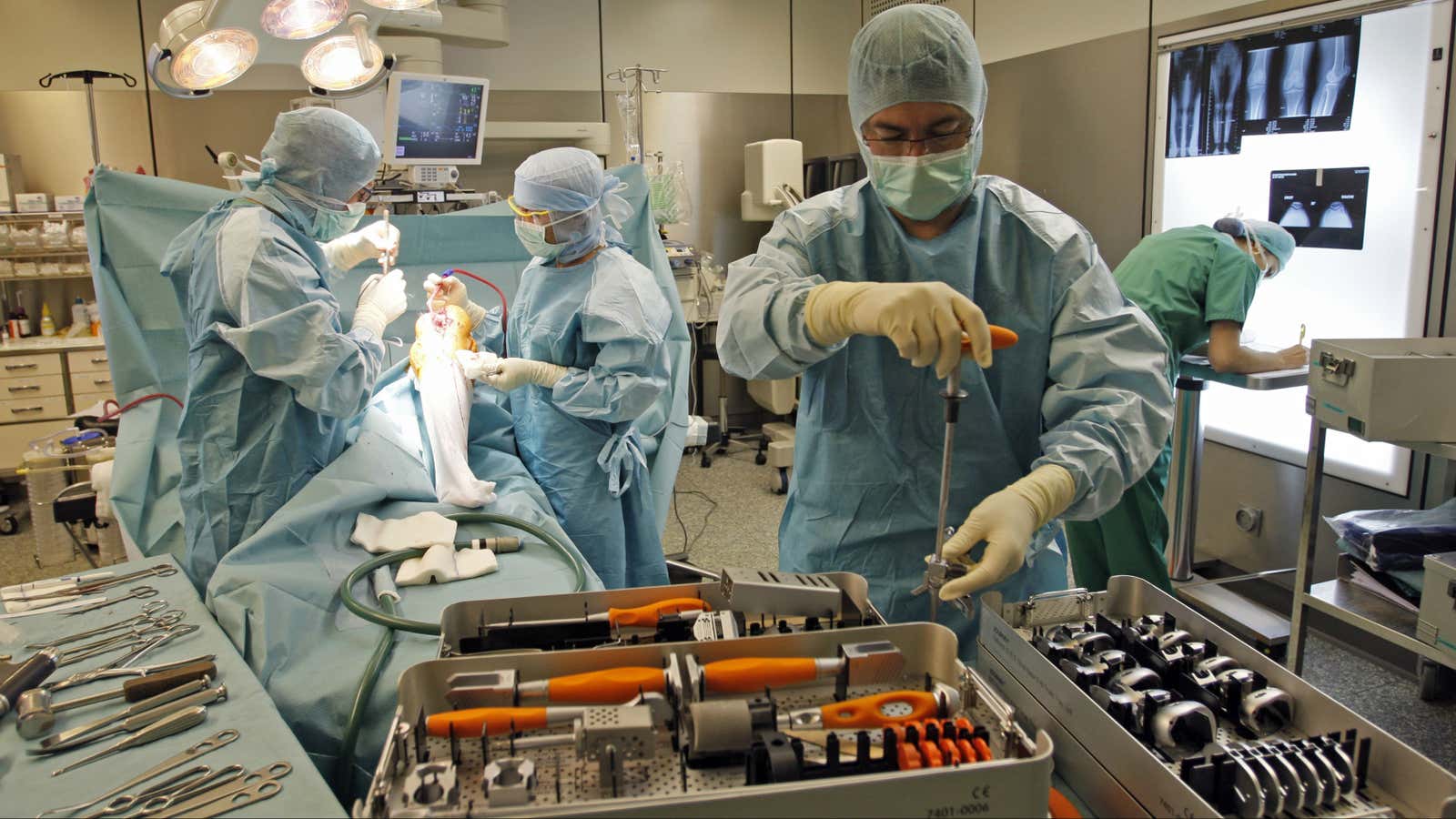The orthopedic surgery wing of a Connecticut hospital, 2021
Day 1: Cavity
It’s so much darker in my new home.
There’s no natural light at all, in fact. I’m completely engulfed in darkness.
Not that I mind—on the contrary, it’s a welcome change of scenery. After that time Glove uprooted me, I’ll take anything.
I’ve never been more terrified.I was minding my own business on Skin, and all of the sudden I was whisked up by Glove. There were a handful of us trapped, and if felt like we were flying through the air until I was plunged deep into Body on some sort of alien vessel made of metal.
I’d never been in the Cavity before; as a Staphylococcus aureus, for generations my family has lived on Skin. We like it dry, and we have to constantly repopulate after washings whisk us off the surface. In the Cavity though, it’s only wet with lots of blood. That said, there appear to be no external elements that would otherwise dislodge us from here, which was the primary threat on Skin. That and resource scarcity.
It’s not what I’m used to, but there are so many more things to eat here, and it’s much less crowded. I think I can make a new home here.
Day 2: Bone
It was some time before I even ran into anyone else down here. He said he was some sort of anaerobe (paywall)—I’d never seen one before. They’re mysterious and keep to themselves.
Anyway, I asked him where I was. He seemed startled by my presence, but slowly he answered. “This is Bone. This is the one of the innermost parts of Cavity.”
“What is Bone?” I asked.
“This is Hip Bone—specifically, the joint region. It used to continue on to Femur, but much of our territory was replaced with Metal recently. Caused quite the shakeup,” he said.
“Seems to have brought in a fresh crop of you all,” he added. I could feel him sizing me up from afar. I get the sense I’m not meant to be here.
Day 3: Bone
Bone seems to be filling up with my kind rather quickly. We all just keep dividing and dividing. But why shouldn’t we? Resources are abundant. There’s no scarcity like before.
Body has sent in some reinforcements. Every hour or so, there are those Neutros that come in and try to trap one of us with their globs of proteins. I’ve heard of these before—I heard stories of others of my kind that made their way deeper into Skin, only to be trapped by the Neutros and then feasted upon alive by the Big Phages.
I was lucky; they never caught me. But I watched them eat generations before me.
Here in Bone, the Neutros and Big Phages trap and kill some of other others, but not many. We are growing so quickly they are overwhelmed.
They sure have tenacity, but they will not beat us down.
Day 4: Bone
Body is getting more aggressive. It’s sending in more and more Neutros and Phages and it’s quickly getting hotter. This is makes it harder to eat and divide, but I see it for what it really is: a sign of desperation. It’s trying to break us with the heat. But I know that Body also can’t operate at high temperatures for long. This will be a battle to see who can outlast the other.
Surely, it will be us. We still vastly outnumber Body cells at this point, and some of us are even starting to fight back (paywall): Fellow Staph have figured out how to take the nets from the Neutros and turn it into a poison for the Phages. Serves them right for trying to stop us.
Day 7: Marrow
It is so hot, and Body has brought external reinforcements.
I believe it’s Penicillin. I’ve heard of rumors of the stuff, but I don’t know details—when it’s come around in the past, none of us lived to tell the tale. I am hiding in a secret pocket of Marrow I’ve found, where the Penicillin doesn’t seem to be able to reach. I fear, though, that it will only be a matter of time before I am taken. So many others around me have been wiped out and cleared away.

Day 10: Marrow
There is a growing Resistance.
I heard a story from another Staph who said she faced the Penicillin, and that it couldn’t hurt her. She said she stared it square in its face, and although it tried to kill her, she could repair herself quickly.
She’s been dividing like crazy as a result; there’s so much more left to eat now that so many of us are gone. Her line is thriving.
She told me that I, too, would withstand the Penicillin. I was afraid at first, but sure enough it met me in my hiding place, and just when I was sure it would all be over, I was still alive. Emboldened, I approached more Penicillin—nothing. They seem to be unable to harm me.
Bone is still ours.
Day 17: Bone
There is no more Penicillin, but I have met another, new hit man Body has hired: Methicillin.
It slashes like a weed-whacker through most of those of us left. Perhaps we got cocky before.
But it’s not that different from the Penicillin. Somethings tells me I don’t need to worry, even if my friends are dying. I know that as long as a few of us can persist, we should be able to recolonize Bone. I feel almost invigorated.
Day 20: Bone
I was right—although the slaughter was mighty, a few of us have made it through and live on. I was one of the survivors. Hip Bone is ours now.
Day 25: Bone
We had days of peace. We grew and grew and grew.
But now there is something else here.
I had never heard of it before, although older generations tell me it used to be commonly used.
“It’s Vancomycin,” said another Staph warily. “I thought it would never be used anymore.”
Vancomycin, she told me, used to come and stop us from building our cell walls, she told me. Without these, we couldn’t grow, and our colonies would die. But, we adapted over the years, and once again we could thrive in Vancomycin’s presence.
Then it went away, and no one saw it for years. Millions of generations came and went with no sign of Vancomycin.
“This seems different,” the ancient one told me. She seemed nervous.
It’s true—it’s smashed through some already. I hope that those were just the weak among us.
Still, I think it’s best to hide.
Day 27: Marrow
This looks bad. Vancomycin has been able to destroy so many of us already, and it’s failing to break down (paywall). It keeps coming and coming and killing and killing.
No one has seen anything like this before; usually any kind of reinforcement Body brings in breaks down eventually. Or harms Body enough that it has to stop. But this is something new—no one knows where or how it came to be. It’s like it handcrafted a killer for us specifically; but how could Body know what we are?
It’s too much to think about, and it hardly matters. Although Body has cooled once more, it’s hardly easy for us to eat and divide like we normally would; we are being hunted and killed faster than we can reproduce.
Day 30: Marrow
I am here, in hiding. Haven’t seen another of my kind. Resources are scarce; if I am to continue, I’ll have to expose myself to the Vancomycin.
Lymph report no. 93,940,599
Routine sweep through left Hip Bone. Picked up several remains from battle with MRSA, to be expelled through Urinary tract. No living MRSA strains encountered; some routine anaerobic activity beginning to stir as thought of the recovery process.
Blood circulating on schedule; no unexpected invaders. Recovery process may proceed.
* * *
This particular account of a Methicillin-resistant Staphylococcus aureus bacterium’s time in a human body is speculative fiction. Vancomycin is a drug that used to work against certain types of infections but lost its efficacy about 60 years ago, as BBC reports. Recently, Californian researchers published work showing that they were improve Vancomycin to make it stronger and longer-lasting, but it’s still very much in the developmental phase; there have been no human or even animal trials yet.
Developing new ways to deal with the threat of hospital-acquired superbug infections is a public health imperative. According to the US Centers for Disease Control, roughly one in 25 hospital patients develops a hospital-acquired infection per day. Hospitals tend to be breeding grounds for bacteria that are resistant to at least one type of drug, simply because any bacteria there are constantly exposed to various antibiotics.
Staph typically live on the skin, but can cause infections in the bones through orthopedic surgeries. These bacteria have been shown to be able to turn some of the body’s immune defenses against itself; they can use proteins to create a toxin that kills macrophages, a type of white blood cell. In these cases, patients need the extra help of antibiotics. Unfortunately, bacteria can develop resistance to these drugs faster than scientists can develop them; new antibiotics haven’t been introduced since the 1980s.
That said, scientists are working tirelessly to come up with improvements to existing drugs, such as Vancomycin, and researchers are also hunting far and wide for new solutions to drug resistance. They’ve been looking in the animal world, and even to other places in the human body, like the nose, for inspiration. Other researchers are developing “eco-biotics,” or slurries of benign bacteria taken from the large intestines of healthy patients, and transplanted into the body of sick patients to eliminate potentially life-threatening infections.
